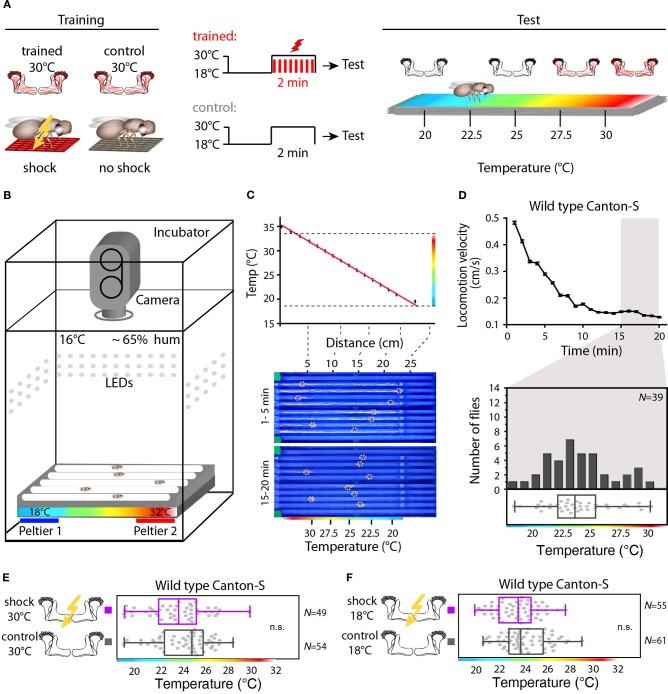Figure 3.
Illustration of the training and temperature preference test. (A) Flies are exposed to 30°C to thermogenetically activate Kenyon cells for 2 min simultaneously with electric shocks (“Training”). A second group of animals is treated equally, but without electric shocks. Subsequently, flies are individually transferred into a temperature gradient arena (“Test”). (B) A metal block with eight walking tracks covered with a Plexiglas lid is equipped at the ends with Peltier elements. The flies can freely distribute for 20 min within each track at 65% air humidity and white light conditions and their locomotion is monitored using a video camera. (C) Upper panel: the Peltier elements create a linear temperature gradient from 18 to 35°C. The red line indicates a linear fit (R2 = 0.99). Lower panel: snapshots of the temperature readout arena indicating positions and locomotion traces of individual flies during the first 5 min (upper part) and during the last 5 min (lower part) of the 20 min observation time. (D) Upper panel: locomotion velocity of naïve wild type flies. Temperature preferences are determined during the last 5 min of the observation period (gray bar), when exploratory behavior is minimal. Lower panel: the bars in the upper part of the graph show the numbers of naïve wild type flies with a preference for the temperature range in 1°C bins indicated on the x-axis. The dots in the lower part indicate temperature preferences for all individual flies. The superimposed lines indicate median and IQR. Whiskers indicate minimum and maximum values. (E) Temperature is not learned as a conditioned stimulus. Temperature preference of wild type Canton-S flies that were incubated for 2 min at 30°C and simultaneously received electric shocks (“trained”) is not significantly different (p > 0.1) from that of flies incubated at 30°C, but without electric shocks (“control”). (F) Wild type Canton-S flies that were trained accordingly, but were incubated for 2 min at 18°C and simultaneously received electric shocks (“trained”) and flies that have been equally treated, but without electric shocks (“control”) did not show any significant difference (p > 0.05) in their temperature preference.

